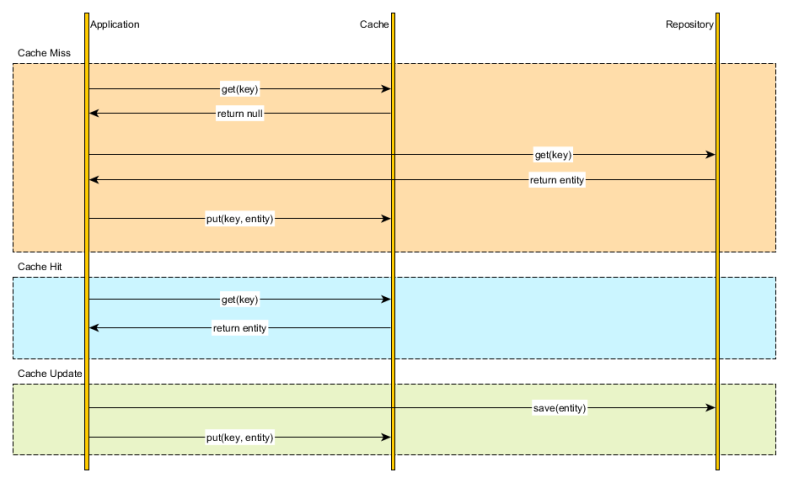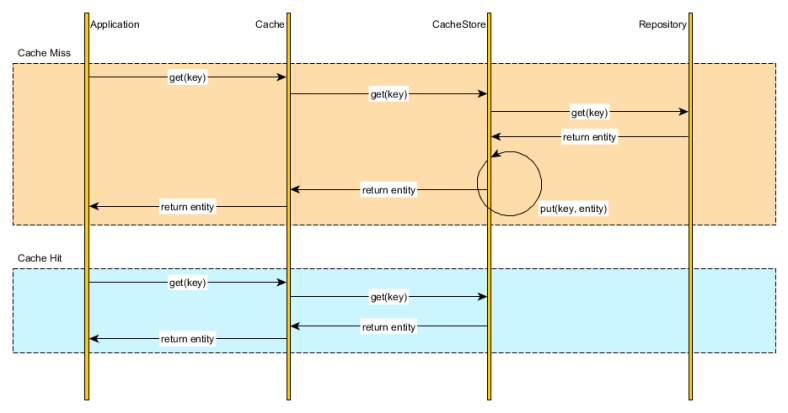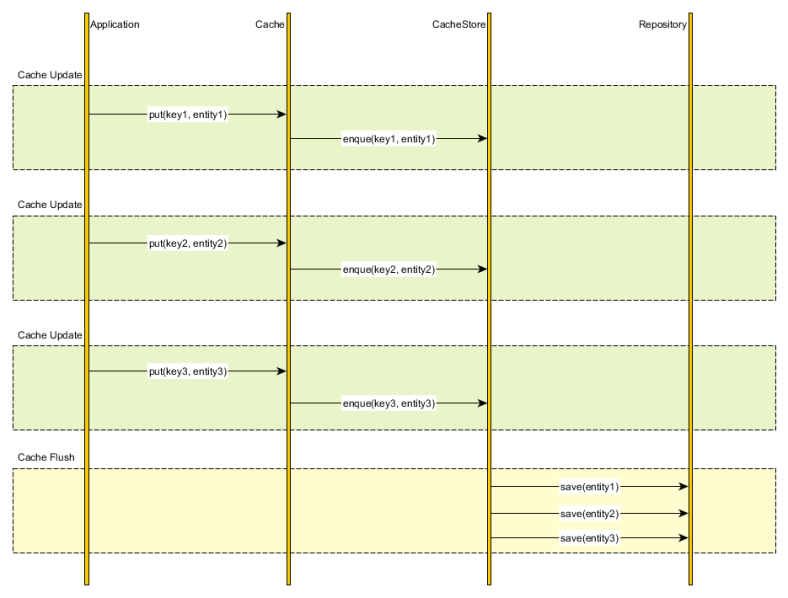A beginner’s guide to Cache synchronization strategies--转载
原文地址:http://vladmihalcea.com/2015/04/20/a-beginners-guide-to-cache-synchronization-strategies/
Introduction
A system of record is the authoritative data source when information is scattered among various data providers. When we introduce a caching solution, we automatically duplicate our data. To avoid inconsistent reads and data integrity issues, it’s very important to synchronize the database and the cache (whenever a change occurs into the system).
There are various ways to keep the cache and the underlying database in sync and this article will present some of the most common cache synchronization strategies.
Cache-aside
The application code can manually manage both the database and the cache information. The application logic inspects the cache before hitting the database and it updates the cache after any database modification.

Mixing caching management and application is not very appealing, especially if we have to repeat these steps in every data retrieval method. Leveraging an Aspect-Oriented caching interceptor can mitigate the cache leaking into the application code, but it doesn’t exonerate us from making sure that both the database and the cache are properly synchronized.
Read-through
Instead of managing both the database and the cache, we can simply delegate the database synchronization to the cache provider. All data interactions is therefore done through the cache abstraction layer.

Upon fetching a cache entry, the Cache verifies the cached element availability and loads the underlying resource on our behalf. The application uses the cache as thesystem of record and the cache is able to auto-populate on demand.
Write-through
Analogous to the read-through data fetching strategy, the cache can update the underlying database every time a cache entry is changed.

Although the database and the cache are updated synchronously, we have the liberty of choosing the transaction boundaries according to our current business requirements.
- If strong consistency is mandatory and the cache provider offers an XAResource we can then enlist the cache and the database in the same global transaction. The database and the cache are therefore updated in a single atomic unit-of-work
- If consistency can be weaken, we can update the cache and the database sequentially, without using a global transaction. Usually the cache is changed first and if the database update fails, the cache can use a compensating action to roll-back the current transaction changes
Write-behind
If strong consistency is not mandated, we can simply enqueue the cache changes and periodically flush them to the database.

This strategy is employed by the Java PersistenceEntityManager (first-level cache), all entity state transitions being flushed towards the end of the current running transaction (or when a query is issued).
Although it breaks transaction guarantees, the write-behind caching strategy can outperform the write-through policy, because database updates can be batched and the number of DML transactions is also reduced.
A beginner’s guide to Cache synchronization strategies--转载的更多相关文章
- Photography theory: a beginner's guide(telegraph.co.uk)
By Diane Smyth, Tim Clark, Rachel Segal Hamilton and Lewis Bush 11:00AM BST 09 Jun 2014 Have you r ...
- A Beginner's Guide to Paxos
Google Drive: A Beginner's Guide to Paxos The code ideas of Paxos protocol: 1) Optimistic concurrenc ...
- Beginner's Guide to Python-新手指导
Refer English Version: http://wiki.python.org/moin/BeginnersGuide New to programming? Python is free ...
- A Beginner's Guide To Understanding Convolutional Neural Networks(转)
A Beginner's Guide To Understanding Convolutional Neural Networks Introduction Convolutional neural ...
- (转)A Beginner's Guide To Understanding Convolutional Neural Networks Part 2
Adit Deshpande CS Undergrad at UCLA ('19) Blog About A Beginner's Guide To Understanding Convolution ...
- (转)A Beginner's Guide To Understanding Convolutional Neural Networks
Adit Deshpande CS Undergrad at UCLA ('19) Blog About A Beginner's Guide To Understanding Convolution ...
- 新手教程之:循环网络和LSTM指南 (A Beginner’s Guide to Recurrent Networks and LSTMs)
新手教程之:循环网络和LSTM指南 (A Beginner’s Guide to Recurrent Networks and LSTMs) 本文翻译自:http://deeplearning4j.o ...
- A Beginner’s Guide to Eigenvectors, PCA, Covariance and Entropy
A Beginner’s Guide to Eigenvectors, PCA, Covariance and Entropy Content: Linear Transformations Prin ...
- A Beginner’s Guide to the OUTPUT Clause in SQL Server
原文 A Beginner’s Guide to the OUTPUT Clause in SQL Server T-SQL supports the OUTPUT clause after the ...
随机推荐
- 如何在 Windows Azure 的虚拟机 ubuntu 上面安装和配置 openVPN(二)
第二步:登录到虚拟机 一旦创建好虚拟机后,默认azure会打开TCP 22端口,即SSH的端口.所以,我们可以通过远程连接,访问和管理该虚拟机. 首先,下载一个PuTTY软件.该软件很简单,就一个可执 ...
- Unbutu网卡驱动安装(Intel内置网卡8086:15b8)
工作中需要在新的实验平台上安装unbuntu14.04操作系统,系统安装好之后发现无法连接网络,分析后是由于缺少网卡驱动的原因. 下面把分析问题的过程及安装网卡驱动步骤介绍如下: 查看PCI信息 su ...
- C语言的指针移位问题
先贴代码 #include <stdio.h> int main(void) { double a[]={1.1,2.2,3.3}; unsigned int b,c,d; b=& ...
- HDU 4891 The Great Pan (模拟)
The Great Pan 题目链接: http://acm.hust.edu.cn/vjudge/contest/123554#problem/D Description As a programm ...
- Web 前端最佳实践
Web 最佳实践 前端 选择器 尽量使用ID选择器 基于Id的选择器:先使用ID选择器定位,然后再使用find方法精确查找 // Fast: $( "#container div ...
- codeforces 630KIndivisibility(容斥原理)
K. Indivisibility time limit per test 0.5 seconds memory limit per test 64 megabytes input standard ...
- Linux平台部署varnish 高性能缓存服务器
一:varnish部署前准备: 1.1相关软件以及系统,web服务 系统要求:Centos 6(以上) (64位) 相关中间件:varnish-4.0.2 1.2相关系统依赖包安装检查准备 1.2.1 ...
- C#中垃圾回收与内存管理机制
今天抽空来讨论一下.Net的垃圾回收与内存管理机制,也算是完成上个<WCF分布式开发必备知识>系列后的一次休息吧.以前被别人面试的时候问过我GC工作原理的问题,我现在面试新人的时候偶尔也会 ...
- Java常用类(String、StringBuffer、Math、Arrays)
1.String 操作对象时会重新分配堆内存,栈内存的引用会重新指向新的堆内存 2.StringBuffer(字符串缓存区) 操作的对象一直都是一个 3.Math Math.max(xx,xx); M ...
- MySQL timestamp用法
与timestamp类型相关的类型包括:date类型与datetime类型.date类型只包含日期部分,不包含时间部分,它的格式为'YYYY-MM-DD',支持的范围为'1000-01-01' to ...
